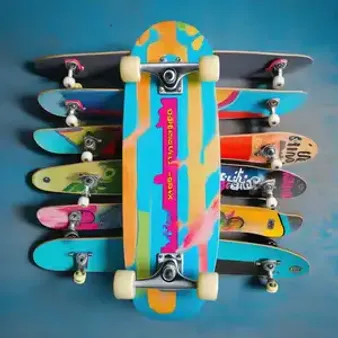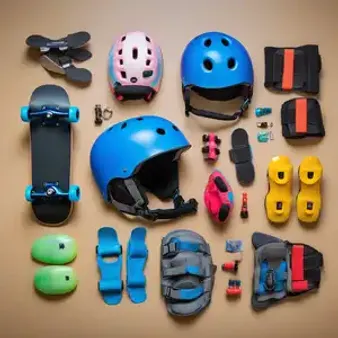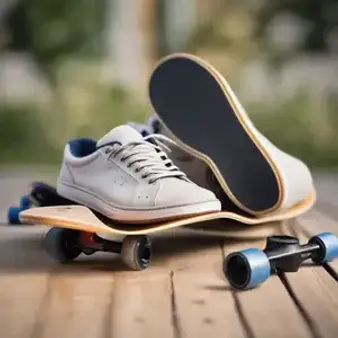Table of Contents
So you're ready to shred! Picking out skateboard gear for beginners can be super exciting, but it can also feel a little overwhelming with so many options. Don't worry, kizworld is here to break it all down. We'll walk you through everything you need to know, from choosing the right board to staying safe and looking the part. Let's get started!
Gear | Description | Tips for Beginners |
|---|---|---|
Skateboard Deck | The wooden board you stand on. | Choose a deck width that feels comfortable for your foot size and skating style. |
Trucks | Metal axles that attach the wheels to the deck. | Look for trucks that match the width of your deck. |
Wheels | Made of polyurethane and come in various sizes and hardness. | Start with softer wheels (around 90A) for a smoother ride on rough surfaces. |
Bearings | Small metal rings that fit inside the wheels, allowing them to spin. | Choose bearings with a higher ABEC rating for a faster, smoother roll. |
Helmet | Essential safety gear to protect your head. | Make sure it fits snugly and meets safety standards. |
Pads | Protect your knees, elbows, and wrists from impacts. | Choose pads that offer a comfortable fit and adequate protection. |
Shoes | Skate shoes provide better grip and board feel. | Look for flat-soled shoes with good grip and durability. |
Choosing the Right Skateboard for Beginners
Deck the Halls (or at Least Your Skateboard)
Okay, first things first—the board! It's tempting to grab that neon green one with skulls, but trust me, starting with a basic skateboard is best. Think of it like learning to ride a bike. You wouldn't hop on a unicycle right away, right? You'd start with something sturdy and easy to handle. The same goes for skateboarding! A classic popsicle-shaped deck is perfect for beginners.
Now, about the size. Decks come in different widths, and you want to pick one that feels comfy for your feet. Stand on a few at the shop and see what feels right. Too narrow, and you'll be feeling wobbly. Too wide, and it'll be tough to control. It's all about finding that sweet spot! Want to improve your balance for skateboarding? Check out our guide on how to improve your balance.
Deck Width | Good For |
|---|---|
7.5" - 8" | Smaller feet, street skating, tech tricks |
8" - 8.25" | Most riders, good all-around size |
8.25" and up | Larger feet, ramps and bowls, stability |
Complete vs. Custom: What's the Deal?
Time to decide—complete skateboard or custom build? A complete is like a pre-built pizza—it comes with all the toppings (er, parts) already chosen for you. This is a super convenient option for beginners because you don't have to stress about picking out each individual piece. Just grab it and go! Plus, they're usually more budget-friendly.
A custom build, on the other hand, is like ordering a bespoke pizza—you get to choose exactly what you want on it. This is awesome if you have specific preferences for your trucks, wheels, and bearings. It's like building your dream skateboard from scratch! If you're just starting out, though, I'd recommend sticking with a complete. You can always upgrade parts later as you progress. Looking for more beginner tips? Check out our guide on how to get started with skateboarding.
- Complete Skateboard
- Custom Build
Choosing the Right Skateboard for Beginners
Essential Safety Gear for Beginner Skateboarders
Alright, let's talk safety gear! It's like when your mom makes you wear a raincoat on a cloudy day—you might think it's not cool, but it's way better to be safe than sorry. Skateboarding is super fun, but it can be kinda gnarly if you take a tumble without protection. Trust me, I've learned this the hard way! Remember that time I tried to land a kickflip down the stairs without any pads? Let's just say my knees still have the scars to prove it.
Protect Your Noggin: Helmets
First up, the helmet. This is non-negotiable, my friends. It's like the seatbelt of the skateboarding world—you just don't mess around with it. A good helmet will protect your precious brain from those unexpected slams. Look for one that fits snugly on your head (no bobble-heading allowed!). It shouldn't be too tight or too loose—you want to be able to breathe and see properly, you know? And hey, helmets come in all sorts of cool designs these days, so you can even find one that matches your style. Thinking about improving your skateboarding skills? Check out our guide on how to train like a skateboarder.
Type of Helmet | Features |
|---|---|
Standard Skate Helmet | Durable outer shell, impact-absorbing liner, adjustable straps |
Full-Face Helmet | Provides additional protection for the face and jaw, ideal for downhill skateboarding or more extreme tricks. |
Suit Up: Pads for All the Things
Next, we've got pads. Now, I know what you're thinking—pads are for wimps, right? Wrong! Even the pros wear pads, and they're, like, the coolest dudes on the planet! Pads are there to protect you from those bumps and bruises that come with the territory of learning to skateboard. Plus, they give you a little extra confidence to try new tricks. It's like having a safety net for your body! If you are looking for the right skateboard, check out our guide on how to choose the right skateboard.
- Knee Pads
- Elbow Pads
- Wrist Guards
Essential Safety Gear for Beginner Skateboarders
Skateboard Gear for Beginners: Shoes and Apparel
Alright, we've got our board, safety gear is covered – now let's talk about looking the part! You don’t need fancy clothes to skateboard, but the right gear can make a big difference. First up, shoes! Regular sneakers can be slippery and hard to control on a skateboard. Skate shoes are designed with flat, grippy soles that give you better board feel. They’re like the sticky paws of a gecko, helping you stay glued to your board! Plus, they often have reinforced areas to withstand all the wear and tear of skateboarding.
When it comes to clothes, comfort is key! Choose loose-fitting, breathable fabrics that allow you to move freely. Think jeans, shorts, t-shirts – whatever you feel comfy shredding in! Some skateboarders like to wear baggy pants for that classic skater style, while others prefer a more fitted look. It’s all about personal preference. Just make sure your clothes aren't so loose that they get caught in your wheels! If you're looking for inspiration, check out our guide on the best skateboarding clothing and apparel. And hey, don’t forget to accessorize! A cool hat or sunglasses can complete your skateboarding look. Ready to learn some tricks? Check out our guide on how to do an ollie, the most fundamental skateboarding trick.
Gear | Benefits |
|---|---|
Skate Shoes | Better grip and board control, reinforced for durability |
Loose-Fitting Clothes | Comfort and freedom of movement |
Accessories (Hat, Sunglasses) | Style and sun protection |
Skateboard Gear for Beginners: Shoes and Apparel
Maintaining Your Skateboard Gear
Taking care of your skateboard gear isn't just about keeping it shiny and new, although that's a bonus! It's about making sure your board performs its best and lasts for ages. Think of it like brushing your teeth—you gotta do it regularly to keep things in tip-top shape. Plus, a well-maintained skateboard is a safer skateboard, and that's what matters most! If you're looking for the perfect skateboard to match your style, check out our guide on how to choose the right skateboard.
Now, you don't need a fancy toolkit or anything. Some basic cleaning and a little TLC go a long way. Trust me, your skateboard will thank you for it! And hey, maybe you'll even discover a hidden talent for fixing things—you never know! Need to upgrade your skateboarding gear? Check out our guide on the best skateboarding equipment and accessories.
Keep It Clean
First things first, let's give that skateboard a spa day! Over time, dirt, grime, and who-knows-what can build up on your deck, trucks, and wheels. Not only does it look kinda gross, but it can affect how well your board rolls. Grab a damp cloth and some mild soap, and gently wipe down your entire board. You'd be surprised how much gunk comes off!
For your grip tape, you can use a soft brush or an old toothbrush to remove any dirt or pebbles that get stuck in there. Remember that gnarly slam you took the other day? Yeah, those pebbles are probably still chilling on your grip tape. And speaking of gnarly slams, always protect yourself with the best skateboarding helmets and pads.
Cleaning Supply | Purpose |
|---|---|
Damp Cloth | Wiping down the deck, trucks, and wheels |
Mild Soap | Removing dirt and grime |
Soft Brush or Old Toothbrush | Cleaning the grip tape |
Show Your Bearings Some Love
Those tiny bearings inside your wheels work super hard, letting you cruise around with speed and style. But they can get clogged with dirt and debris, making your ride feel sluggish. Time for a little bearing maintenance! Now, you can definitely find tutorials online for cleaning and lubing your bearings, but if you're not comfortable taking things apart, it's totally cool to ask a more experienced skater or even a skate shop employee for help. They're usually happy to share their knowledge! For tips on improving your skateboarding skills, check out our guide on how to train like a skateboarder.
- Clean your bearings regularly to remove dirt and debris.
- Lubricate your bearings with a specialized skateboard bearing lubricant.
- Avoid riding your skateboard through water or excessively dusty areas.
- Store your skateboard in a cool, dry place to prevent rust and corrosion.
Maintaining Your Skateboard Gear
Final Thought
Getting the right skateboard gear for beginners is the first step on your skateboarding journey. Remember, safety comes first, so always wear protective gear. Don't be afraid to experiment and find what works best for you. Most importantly, have fun and enjoy the ride!